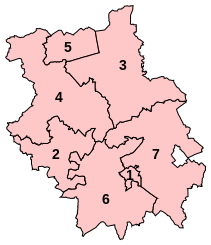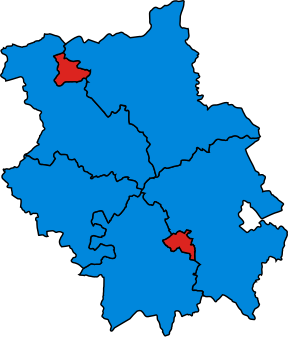Top Qs
Timeline
Chat
Perspective
Parliamentary constituencies in Cambridgeshire
From Wikipedia, the free encyclopedia
Remove ads
The ceremonial county of Cambridgeshire (which includes the area of the Peterborough unitary authority) is divided into eight parliamentary constituencies. There is one borough constituency and seven county constituencies, which each elect one Member of Parliament to represent it in the Parliament of the United Kingdom.

Remove ads
Constituencies
† Conservative ‡ Labour ¤ Liberal Democrat ± Reform
Remove ads
Boundary changes
Summarize
Perspective
2024
For the 2023 Periodic Review of Westminster constituencies, which redrew the constituency map ahead of the 2024 United Kingdom general election, the Boundary Commission for England retained Cambridgeshire as a sub-region of the East of England region, increasing the number of seats from seven to eight with the creation of St Neots and Mid Cambridgeshire. The town of St Neots was transferred from Huntingdon and the Mid Cambridgeshire areas, including the new towns of Cambourne and Northstowe, from South Cambridgeshire and South East Cambridgeshire. As a consequence, there were significant changes to the existing constituency boundaries, apart from Peterborough, which was largely unchanged. South East Cambridgeshire was renamed Ely and East Cambridgeshire.
2010
The 2007 report of the Boundary Commission for England retained the same seven constituencies that had existed since the 1997 election, with minor boundary changes to align with current local government wards and to better equalise the electorates. These changes, which were implemented at the 2010 general election, included the transfer back of Thorney and Eye from North East Cambridgeshire to Peterborough, the return of the Cambridge ward of Trumpington from South Cambridgeshire to the Cambridge constituency, and small transfers of rural wards from North West Cambridgeshire to Huntingdon, and from South East Cambridgeshire to South Cambridgeshire.
Remove ads
Results history
Summarize
Perspective
Primary data source: House of Commons research briefing - General election results from 1918 to 2019[5]
2024
The number of votes cast for each political party who fielded candidates in constituencies comprising Cambridgeshire in the 2024 general election were as follows:[2]
2019
The number of votes cast for each political party who fielded candidates in constituencies comprising Cambridgeshire in the 2019 general election were as follows:
Percentage votes
11983 & 1987 - SDP-Liberal Alliance
2As the Brexit Party in 2019
* Included in Other
Seats
11983 & 1987 - SDP-Liberal Alliance
Maps
1885–1910
1918–1945
1950–1979
1983–present
Remove ads
Timeline
Remove ads
Historical representation by party
Summarize
Perspective
A cell marked → (with a different colour background to the preceding cell) indicates that the previous MP continued to sit under a new party name.
1852 to 1885
Conservative Liberal Radical Whig
1885 to 1918
1918 to 1950
Coalition Liberal (1918–1922) / National Liberal (1922–1923) Conservative Labour Liberal National Liberal (1931–1968)
1950 to 1983
Conservative Labour Liberal National Liberal (1931–1968)
1transferred from Northamptonshire
1983 to present
Change UK Conservative Independent Labour Liberal Liberal Democrats
Remove ads
See also
Notes
- BC denotes borough constituency, CC denotes county constituency.
- The majority is the number of votes the winning candidate receives more than their nearest rival.
- As of the 2024 general election.
References
Wikiwand - on
Seamless Wikipedia browsing. On steroids.
Remove ads






































